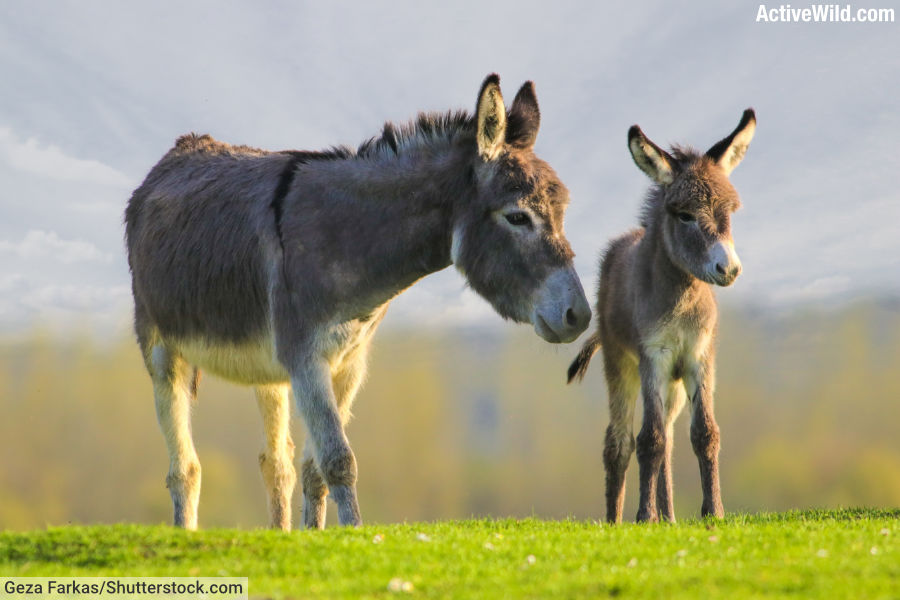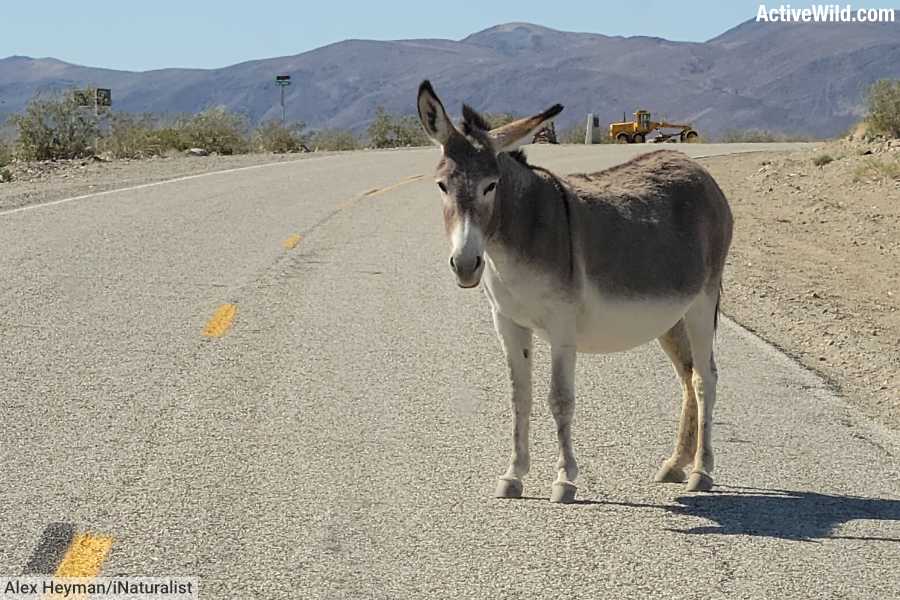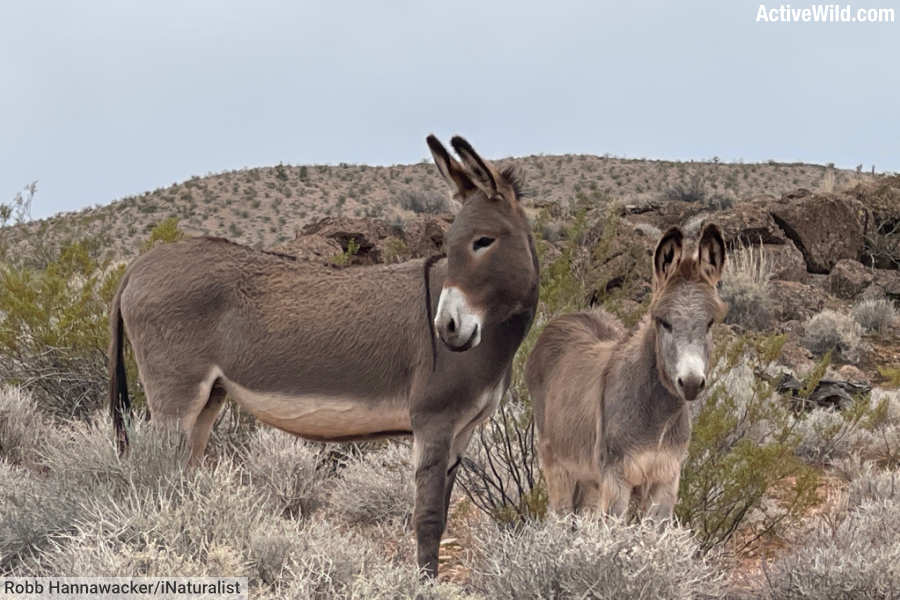Often overshadowed by their equine cousins the horse and zebra, donkeys have nevertheless played a pivotal role in shaping human history, culture, and agriculture.
On this page, we delve into the fascinating world of donkeys, exploring their origin, domestication, and the unique traits that make them indispensable to communities worldwide.
Read on for our top ten donkey facts, followed by in-depth information on this unsung hero of the animal kingdom…
Page Index
Top Ten Donkey Facts

- Donkeys were domesticated at least 5,000 years ago, and were among the first domesticated animals (although both dogs and sheep were domesticated even earlier).
- Donkeys were first domesticated in northeast Africa, in the region now roughly covered by the countries Egypt and Sudan.
- The wild ancestor of the domestic donkey is the African wild ass (Equus africanus). Today, the African wild ass is critically endangered, with a wild population consisting of under 300 adult individuals.
- An adult male donkey is known as a ‘jack’ or ‘jackass’; an adult female is known as a ‘jenny’ or ‘jennet’; and an infant (of either sex) is known as a ‘foal’.
- Donkeys are known for their characteristic braying sound, which is spelled phonetically as ‘hee-haw’ in the USA, and ‘eeyore’ in Britain.
- The donkey is one of seven living species in the horse family Equidae (some authorities recognize more than seven species). Other members of the horse family include horses, asses and zebras.
- In Christianity, the donkey is symbolically important as the animal that carried Mary to Bethlehem before the birth of Jesus. The donkey is also celebrated as the mount of Jesus during his triumphal entry into Jerusalem, an event commemorated on Palm Sunday.
- Donkeys are often used as guard animals for livestock because they have a natural aversion to canines and will bray loudly, chase, and even attack intruders or predators like foxes and coyotes, thereby protecting sheep, goats, and other farm animals.
- Famous fictional donkeys include Eeyore from "Winnie the Pooh", Donkey from "Shrek", Benjamin from "Animal Farm", and Brighty from “Brighty of the Grand Canyon” (a story based on a real donkey).
- A mule is the hybrid offspring of a male donkey and a female horse. Mules inherit strength and endurance from the donkey and speed and agility from the horse, making them hardy and reliable work animals. A hinny is the less common hybrid offspring of a female donkey and a male horse.
Donkey Stats
- Scientific Name: Equus asinus (if considered a separate species) / Equus africanus asinus (if considered a subspecies of African wild ass)
- Order: Perissodactyla
- Family: Equidae
- Height: 0.9 to 1.5 meters / 2.95 to 4.92 feet (at the shoulder, depending on breed)
- Weight: 80 to 480 kg / 176 to 1,058 lb (depending on breed)
What is a Donkey?

A donkey is a domesticated hoofed mammal of the horse family (Equidae) descended from the African wild ass.
Today, the donkey is considered to be either a subspecies of the African wild ass, and given the scientific name Equus africanus asinus, or a separate species, with the scientific name Equus asinus.
Donkeys have been used as working animals for at least 5000 years. They are reliable pack animals with a reputation for being sturdy, independent, and intelligent.
Donkeys vary considerably in size, depending on their breed, but typically they have a stocky build with long ears and a tufted tail. They are smaller than horses and most pony breeds, and similar in size to most zebras.
Although known for their patient and generally gentle disposition, donkeys can also be quite playful and affectionate with their human handlers.
Donkeys are adaptable to many different environments and can be found all over the world. In many developing countries, donkeys are used primarily as draught or pack animals, while in more developed countries, they are increasingly kept for companionship, therapeutic purposes, and educational activities.
Donkey Sound
Donkeys are known for their loud and characteristic bray. This sound is spelled phonetically as ‘hee-haw’ or ‘eeyore’.
Due to their loud bray, alert nature and tendency to be wary of canines, donkeys are often used for guarding livestock against predators.
Donkey Family And Related Species

The donkey is part of the Equidae family, which includes horses, asses and zebras. All these animals are perissodactyls, a group of ungulates (hoofed animals) characterized by an odd number of toes and a hoof at the tip of each toe.
You can see every species of horse on this page: Horse Species List With Pictures & Facts
Another name for perissodactyls is “odd-toed ungulates”. The group also includes animals such as rhinos and tapirs.
Within the Equidae family, donkeys are most closely related to horses. This relationship is evident in their similar body structures, such as their long legs, single-toed hooves, and dental and digestive characteristics.
However, each has evolved distinct traits adapted to their specific environments and roles - for instance, horses for speed and agility, zebras for survival in African savannas, and donkeys for endurance and strength in arid landscapes.
Donkeys are able to breed with horses, and such interbreeding results in hybrids like mules (horse-donkey) and hinnies (donkey-horse), although these hybrids are usually sterile.
What Does A Donkey Look Like?

Donkeys can be recognized by their sturdy, robust build and long ears, which are often much longer than those of horses, their close relatives. The ears help to dissipate heat and are also highly sensitive, which makes donkeys very aware of their environment.
The manes of donkeys are typically short and stand erect, unlike the flowing manes of horses. Their tails are not bushy all the way through but have a tuft of hair at the end, which is different from the tails of horses that have long hair from base to tip.
The coat of a donkey can vary in color, with the most common shades being gray, brown, black, white, or a combination.
Many donkeys have a dorsal stripe (a dark stripe that runs down the middle of the back) and a shoulder cross, which is a stripe that runs across the shoulders meeting the dorsal stripe.

Donkeys have a compact frame with strong, stocky legs suited for bearing heavy loads. Their hooves are smaller and rounder than those of horses, providing durability and performance in rocky terrains.
Donkeys tend to be less sleek than horses and are often smaller in size, although this can vary widely among different breeds. Their physical characteristics are a result of adaptations to environments that are typically harsh, where resources like food and water are scarce.
Donkey Lifespan
On average, donkeys live about 25 to 30 years, but with proper care and management, some donkeys have been known to live into their 40s or even reach 50 years of age.
The lifespan of a donkey can vary depending on factors like breed, environment, and the quality of care it receives.
When And How Did Donkeys Become Domesticated?
Evidence suggests that donkeys became domesticated at least 5,000 years ago; perhaps as far back as 7,000 years. Although donkeys were among the first animals to be domesticated, both the dog and the sheep had likely become domesticated even earlier.
The domestication of donkeys is believed to have occurred in Northeast Africa, specifically in the region that corresponds to modern-day Egypt and Sudan.
The wild ancestor of the domestic donkey is the African wild ass (Equus africanus), which was tamed by the pastoral communities in the Nile Valley during the Predynastic and Early Dynastic periods.
These early domesticated donkeys were used primarily for their strength and stamina, which made them excellent for transportation and carrying goods across the harsh desert landscapes. They could endure in areas where horses, being more susceptible to numerous diseases and requiring more water, could not thrive.
The ability of donkeys to carry heavy loads over long distances without much water or food made them indispensable to the development of long-distance trade routes. Their use rapidly spread throughout the ancient world, from Northeast Africa to the Middle East, and they played a crucial role in the growth of early trade and agriculture.
As human societies grew and became more complex, donkeys continued to be bred selectively for various traits, such as size, strength, and temperament, leading to the diverse breeds of donkeys we see today. The domestication of donkeys had a significant impact on the development of human civilizations around the world.
Famous Donkeys
Famous fictional and non-fictional donkeys include:
- Benjamin from George Orwell's "Animal Farm" - A cynical donkey who doubts the revolution will change anything.
- Brighty of the Grand Canyon - A real-life donkey who roamed the Grand Canyon area in the early 20th century and became the subject of a children’s book and a movie.
- Dapple, Sancho Panza's donkey in Miguel de Cervantes' "Don Quixote," though it is a fictional work, Dapple is a significant character and is well-recognized in literary contexts.
- Dominick the Donkey - The subject of a well-known Christmas song by Lou Monte.
- Donkey from DreamWorks' "Shrek" series - A talkative and hilarious character who becomes Shrek's best friend.
- Eeyore from A.A. Milne's "Winnie the Pooh" series - Known for his gloomy and pessimistic personality.
- Puzzle from C.S. Lewis's "The Chronicles of Narnia" - A character in "The Last Battle" who is tricked into serving as a false Aslan.
- Balaam's Donkey - In the Bible, this is the donkey that spoke to the prophet Balaam on his journey.
Discover More With Active Wild
Visit our main animals page for links to animal information and a complete guide to the animal kingdom: Animals
You can see every species of horse on this page: Horse Species List With Pictures & Facts
Discover amazing animals from all around the world: Animals Around The World
You can see more animals associated with Christmas on this page: Christmas Animals


